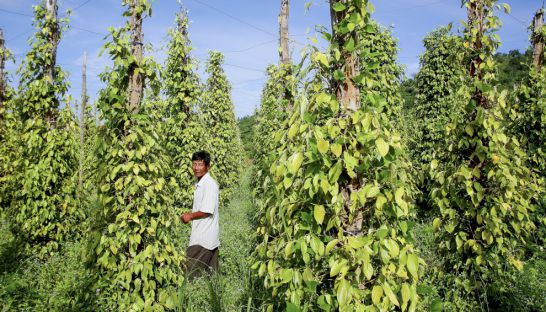Kampot pepper defying drought fears
Kampot pepper defying drought fears
The increased cultivation area of Kampot pepper has offset losses due to drought, with farmers of the premium quality peppercorn estimating that production could reach 80 tonnes in the coming harvest, nearly 40 per cent more than last season.

“Even though our farms were impacted by the drought, the total of harvested land has increased,” Ngoun Lay, president of the Kampot Pepper Promotion Association (KPPA), said yesterday.
The association’s 242 members have planted pepper trees on 100 hectares. Lay said he expects 40 hectares will be ready for the next harvest in late-February, yielding 70 tonnes to 80 tonnes of certified Kampot pepper.
This would be a 38 per cent increase over last season’s harvest, which saw 58 tonnes produced on 25 hectares under cultivation.
Kampot pepper was awarded the World Trade Organisation’s geographical indication (GI) status in 2010, linking the quality of the product to its origin and unique attributes.
Exports and prices rose sharply after receiving the status, but prices have levelled off at around $15 per kilogram for black pepper, $25 per kilogram for red pepper, and $27 per kilogram for white pepper.
Demand, however, continues to grow. Lay said orders have already been received to cover 80 per cent of the upcoming season’s production. About 70 per cent of the orders were placed by international buyers, while 30 per cent were for domestic supply.
The market’s appetite for the premium pepper has encouraged more farmers to join the KPPA. Lay said 30 families have applied for membership, which would expand the association’s total cultivation area by about 50 hectares.
But the members must first be carefully vetted to ensure the product’s quality.
“We always have an annual meeting where we announce the new members and release information on what we have already accomplished and what we plan to do in the future,” he said. “Fifty hectares of pepper farms will be added to association after we check whether or not they meet our criteria.”
He said only members living in Kampot province and producing peppercorns according to the GI designation’s specifications can use the label.
KPPA recently found a number of merchants falsely claiming their product was certified Kampot pepper, though without the distinguishing printed codes on the packaging of the original.
“Our peppercorn has a reputation in the international market because of its quality and this has fuelled its high demand,” said Lay. “We found there is a lot of fake Kampot pepper in the market . . . and we have called the economic police to investigate these cases.”
Phok Ly, a 69-year-old farmer with 3,000 pepper trees under cultivation, said the association’s efforts to maintain quality have resulted in higher incomes for its members.
“Our peppercorn sells at a high price and has been recognised as the finest quality pepper because we follow the association’s guidelines,” he said.
Farmer Sok Huy, who cultivates 20,000 peppercorn trees on 10 hectares of land, recently applied to join the KPPA. He said peppercorns sold under the Kampot pepper label fetch twice the price of those without the designation.
“It’s really important to be a member of KPPA because we get a certificate from the association [to certify the Kampot pepper designation] and can sell our pepper either directly to the buyer or through the association,” he said.
Huy said he expects to receive membership because his farm has followed the association’s guidelines since it first planted pepper trees. KPPA representatives will inspect the farm by the end of the year to determine its status.













